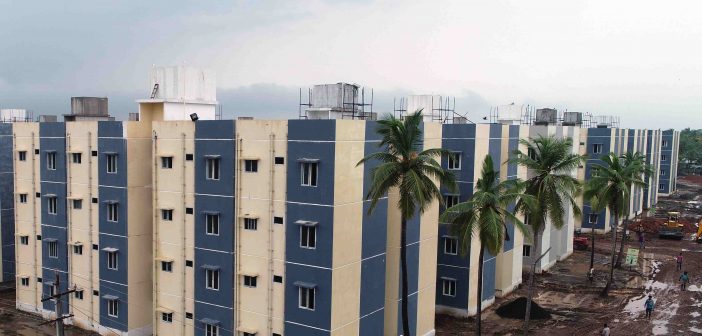Highlights: Of total 1,39,490 units launched across top 7 cities in H1 2019, only 39,840 units fall within Govt-defined affordable category criteria (60 sq. mt. carpet area & priced <INR 45 lakhs)
MMR saw maximum launches at 17,700 units, followed by Pune with 9,350 units; urban housing shortage in Maharashtra alone pegged at 19.7 lakh units
Bangalore, Chennai, Hyderabad & Kolkata together comprise just 15% share (approx. 5,820 new units) of total affordable supply
Nearly 2.40 lakh unsold units across the top 7 cities as on Q2 2019 are affordable but many fall outside the government’s narrow ‘affordable’ definition – see an increase of nearly 3% against Q2 2018
Only a paltry number of developers have built housing that meets the Government’s criteria for incentivized affordable housing in 2019. ANAROCK data reveals that of the total housing supply of 1,39,490 units in the top 7 cities H1 2019, merely 39,840 units meet these criteria. The Government’s recent Budget ‘bonanza’ of an additional INR 1.5 lakh tax deduction on interest repayment of home loans availed till March 2020 will benefit very few people in urban India.
To avail credit subsidy benefits along with the new Budget sops for affordable housing, a home must be priced <INR 45 lakhs and not exceed 60 sq. mt. carpet area or approx. 850 sq. ft. built-up area, including overall loading. Of the 1,39,490 units launched in H1 2019 in the top 7 cities, merely 29% of units qualify under the government-stipulated affordable category.
Of the housing shortage of 19 million units in urban India, nearly 96% pertains to the EWS and LIG categories – the target of the government’s affordable housing push. As per ANAROCK research, nearly 2.40 lakh units that are unsold across the top 7 cities as on Q2 2019 are in the affordable category but many of these do not comply with the government’s narrow ‘affordable’ definition. This unsold stock has increased by nearly 3% against the corresponding period in 2018.
|
City |
Total New Supply in H1 2019 |
New Supply in H1 2019 <INR 45 lakh & <60 sq. m. |
|
NCR |
21,600 |
6,970 |
|
MMR |
49,890 |
17,700 |
|
Bangalore |
20,080 |
2,520 |
|
Pune |
28,220 |
9,350 |
|
Hyderabad |
9,000 |
880 |
|
Chennai |
7,060 |
2,070 |
|
Kolkata |
3,640 |
350 |
|
Total |
1,39,490 |
39,840 |
Source: ANAROCK Research
MMR topped the list with the maximum launches of 17,700 units in this category. Pune came in a distant second with 9,350 units. The urban housing shortage in Maharashtra is pegged at 19.7 lakh homes.
NCR saw the launch of 6,950 units in this category in H1 2019.
Bangalore, Chennai, Hyderabad and Kolkata together accounted for a mere 15% share at approx. 5,820 new units in this category in H1 2019.
Hurdles
Unlike earlier, developers are quite keen on affordable housing, despite the lower profit margins when compared to the luxury or ultra-luxury segments. Supply follows demand – to illustrate, prominent developer Puravankara’s affordable brand Provident Housing jacked up its new supply in Q4 2018 jump to 10.59 mn sq. ft. as against 6.63 mn sq. ft. a year earlier, while Puravankara’s premium housing supply saw a 5% decline over the same period.
Nevertheless, there are ‘natural’ barriers to deploying more supply in the government-stipulated affordable category:
High input costs in urban areas – High land prices in the municipal limits of the major cities (where urban affordable housing is most needed) make it unfeasible for developers to launch affordable housing projects there
Low buyer interest in peripheries – Lack of basic infrastructure in the peripheral areas (where housing within INR 45 lakh is feasible) discourages buyer interest, which curtails supply
Scarcity of land – The main ingredient for housing development is scarce in the main cities
Restrictive affordable housing criteria – The government has put an excessively limiting cap on what kind of housing qualifies for incentives and sops.
Solutions
Unlock government-held land for development:
Across cities, some portions of land falling under the departments of Heavy Industries, Indian Railways, Port Trusts, etc. can be released by the respective government bodies. The infusion of low-cost land will also help curtail property prices.
Revise the price definition of affordable homes in top cities
The government must seriously consider revising the pricing of homes that fall within the affordable housing price band, city-wise. While the prescribed unit size of 60 sq. m. carpet area is fairly appropriate, the prescribed pricing restrictions are not viable across most cities except in the far-flung peripheries which lack liveability and accessibility.
If this price restriction is widened, many more homes will fall within the affordable price tag and qualify. As a result, many more aspiring property buyers can avail the multiple benefits such as lower GST rates at 1% without ITC, government subsidies and the most recent tax deduction of total INR 3.5 lakh on interest repayment of home loans. Such a boost to housing sales cannot come soon enough.
By: Anuj Puri, Chairman – ANAROCK Property Consultants
Track2Realty is an independent media group managed by a consortium of journalists. Starting as the first e-newspaper in the Indian real estate sector in 2011, the group has today evolved as a think-tank on the sector with specialized research reports and rating & ranking. We are editorially independent and free from commercial bias and/or influenced by investors or shareholders. Our editorial team has no clash of interest in practicing high quality journalism that is free, frank & fearless.
Now you can subscribe our YouTube Channel @ https://bit.ly/2tDugGl





